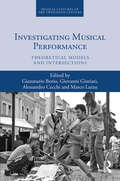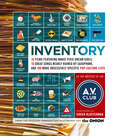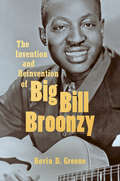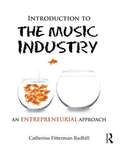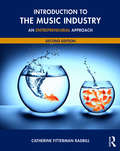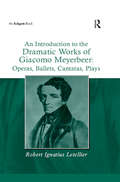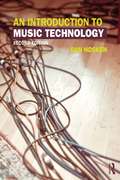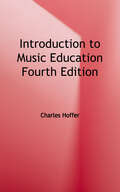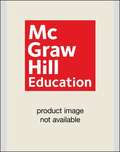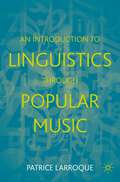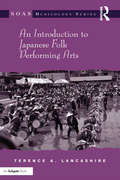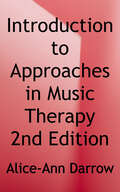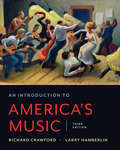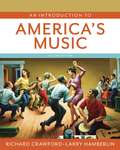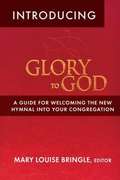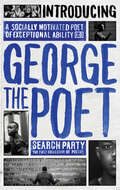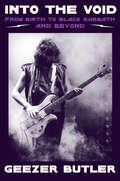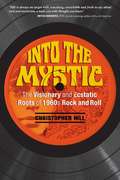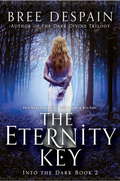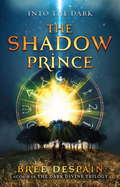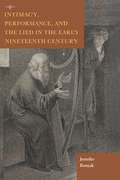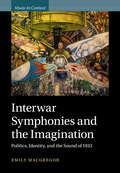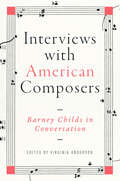- Table View
- List View
Investigating Musical Performance: Theoretical Models and Intersections (Musical Cultures of the Twentieth Century)
by Gianmario Borio Giovanni Giuriati Alessandro Cecchi Marco LutzuInvestigating Musical Performance considers the wide range of perspectives on musical performance made tangible by the cross-disciplinary studies of the last decades and encourages a comparison and revision of theoretical and analytical paradigms. The chapters present different approaches to this multi-layered phenomenon, including the results of significant research projects. The complex nature of musical performance is revealed within each section which either suggests aspects of dialogue and contiguity or discusses divergences between theoretical models and perspectives. Part I elaborates on the history, current trends and crucial aspects of the study of musical performance; Part II is devoted to the development of theoretical models, highlighting sharply distinguished positions; Part III explores the relationship between sign and sound in score-based performances; finally, the focus of Part IV centres on gesture considered within different traditions of musicmaking. Three extra chapters by the editors complement Parts I and III and can be accessed via the online Routledge Music Research Portal. The volume shows actual and possible connections between topics, problems, analytical methods and theories, thereby reflecting the wealth of stimuli offered by research on the musical cultures of our times.
Inventory
by Chuck Klosterman A. V. ClubEach week, the writers of The A.V. Club issue a slightly slanted pop-culture list filled with challenging opinions (Is David Bowie's "Young Americans" nearly ruined by saxophone?) and fascinating facts. Exploring 24 great films too painful to watch twice, 14 tragic movie-masturbation scenes, 18 songs about crappy cities, and much more, Inventory combines a massive helping of new lists created especially for the book with a few favorites first seen at avclub.com and in the pages of The A.V. Club's sister publication, The Onion. But wait! There's more: John Hodgman offers a set of minutely detailed (and probably fictional) character actors. Patton Oswalt waxes ecstatic about the "quiet film revolutions" that changed cinema in small but exciting ways. Amy Sedaris lists 50 things that make her laugh. "Weird Al" Yankovic examines the noises of Mad magazine's Don Martin. Plus lists from Paul Thomas Anderson, Robert Ben Garant, Tom Lennon, Andrew W.K., Tim and Eric, Daniel Handler, and Zach Galifianakis -- and an epic foreword from essayist Chuck Klosterman.
The Invention of Beethoven and Rossini
by Nicholas Mathew Benjamin WaltonBeethoven and Rossini have always been more than a pair of famous composers. Even during their lifetimes, they were well on the way to becoming 'Beethoven and Rossini' – a symbolic duo, who represented a contrast fundamental to Western music. This contrast was to shape the composition, performance, reception and historiography of music throughout the nineteenth and twentieth centuries. The Invention of Beethoven and Rossini puts leading scholars of opera and instrumental music into dialogue with each other, with the aim of unpicking the origins, consequences and fallacies of the opposition between the two composers and what they came to represent. In fifteen chapters, contributors explore topics ranging from the concert lives of early nineteenth-century capitals to the mythmaking of early cinema, and from the close analysis of individual works by Beethoven and Rossini to the cultural politics of nineteenth-century music histories.
The Invention and Reinvention of Big Bill Broonzy
by Kevin D. GreeneOver the course of his long career, legendary bluesman William "Big Bill" Broonzy (1893–1958) helped shape the trajectory of the genre, from its roots in the rural Mississippi River Delta, through its rise as a popular genre in the North, to its eventual international acclaim. Along the way, Broonzy adopted an evolving personal and professional identity, tailoring his self-presentation to the demands of the place and time. His remarkable professional fluidity mirrored the range of expectations from his audiences, whose ideas about race, national belonging, identity, and the blues were refracted through Broonzy as if through a prism. Kevin D. Greene argues that Broonzy's popular success testifies to his ability to navigate the cultural expectations of his different audiences. However, this constant reinvention came at a personal and professional cost. Using Broonzy's multifaceted career, Greene situates blues performance at the center of understanding African American self-presentation and racial identity in the first half of the twentieth century. Through Broonzy's life and times, Greene assesses major themes and events in African American history, including the Great Migration, urbanization, and black expatriate encounters with European culture consumers. Drawing on a range of historical source materials as well as oral histories and personal archives held by Broonzy's son, Greene perceptively interrogates how notions of race, gender, and audience reception continue to shape concepts of folk culture and musical authenticity.
Introduction to the Music Industry: An Entrepreneurial Approach
by Catherine Fitterman RadbillIntroduction to the Music Industry: An Entrepreneurial Approach is an introductory textbook that offers a fresh look at one of the fastest-changing businesses in the world today. Emphasizing the importance of entrepreneurial thinking for the music industry, this textbook engages college-level students in learning the fundamentals of the music business while discovering ways to shape the industry's future. Every chapter explores the inner workings of the music industry, using creative problem-solving exercises, discussion questions, collaborative projects, case studies, hands-on activities, and inspiring stories of actual music entrepreneurs. The textbook's companion website provides multi-media content, study guides, and an instructor's manual with lesson plans and suggestions for assessing students' work. This book will be beneficial to students who want to learn the basics of the music industry and be involved in some way, whether a professional working in support of artists, or an artist trying to launch his or her performing career.
Introduction to the Music Industry: An Entrepreneurial Approach, Second Edition
by Catherine Fitterman RadbillIntroduction to the Music Industry: An Entrepreneurial Approach, Second Edition is an introductory textbook that offers a fresh perspective in one of the fastest-changing businesses in the world today. It engages students with creative problem-solving activities, collaborative projects and case studies as they explore the inner workings of the music business, while encouraging them to think like entrepreneurs on a path toward their own successful careers in the industry. This new edition includes a revised chapter organization, with chapters streamlined to focus on topics most important to music business students, while also maintaining its user-friendly chapter approach. Supported by an updated companion website, this book equips music business students and performance majors with the knowledge and tools to adopt and integrate entrepreneurial thinking successfully into practice and shape the future of the industry.
An Introduction to the Dramatic Works of Giacomo Meyerbeer: Operas, Ballets, Cantatas, Plays
by Robert Ignatius LetellierGiacomo Meyerbeer (1791-1864) was a great musical dramatist in his own right. The fame of his operas rests on his radical treatment of form, his development of scenic complexes and greater plasticity of structure and melody, his dynamic use of the orchestra, and close attention to all aspects of presentation and production, all of which set new standards in Romantic opera and dramaturgy. This book carries forward the process of rediscovery and reassessment of Meyerbeer‘s artincluding not just his famous French operas, but also his German and Italian ones placing them in the context of his entire dramatic oeuvre, including his ballets, oratorios, cantatas and incidental music. From Meyerbeer‘s first stage presentation in 1810 to his great posthumous accolade in 1865, some 24 works mark the unfolding of this life lived for dramatic music. The reputation of the famous four grand operas may well live on in the public consciousness, but the other works remain largely unknown. This book provides an approachable introduction to them. The works have been divided into their generic types for quick reference and helpful association, and placed within the context of the composer‘s life and artistic development. Each section unfolds a brief history of the work‘s origins, an account of the plot, a critical survey of some of its musical characteristics, and a record of its performance history. Robert Letellier examines each work from a dramaturgical view point, including the essential often challenging philosophical and historical elements in the scenarios, and how these concepts were translated musically onto the stage. A series of portraits and stage iconography assist in bringing the works to life.
An Introduction to Music Therapy Theory and Practice Third Edition
by William B. Davis Kate E. Gfeller Michael H. Thaut"An Introduction to Music Therapy: Theory and Practice, third edition, provides a comprehensive overview of the practice of music therapy for the 21st century. It looks at where we have been, where we are today, and where we might be in the future. Combining sound pedagogy with recent research findings, this new edition has been updated and expanded to reflect changes in music therapy practice over the past nine years.
An Introduction to Music Technology
by Dan HoskenAn Introduction to Music Technology, Second Edition provides a clear overview of the essential elements of music technology for today's musician. This book focuses on the topics that underlie the hardware and software in use today: Sound, Audio, MIDI, Computer Notation, and Computer- Assisted Instruction. Appendices cover necessary computer hardware and software concepts. Written for both music technology majors and non-majors, this textbook introduces fundamental principles and practices so students can learn to work with a wide range of software programs, adapt to new music technologies, and apply music technology in their performance, composition, teaching, and analysis. Features: Thorough explanations of key topics in music technology Content applicable to all software and hardware, not linked to just one piece of software or gear In-depth discussion of digital audio topics, such as sampling rates, resolutions, and file formats Explanations of standard audio plug-ins including dynamics processors, EQs, and delay based effects Coverage of synthesis and sampling in software instruments Pedagogical features, including: Further Reading sections that allow the student to delve deeper into topics of interest Suggested Activities that can be carried out with a variety of different programs Key Terms at the end of each chapter What Do I Need? Chapters covering the types of hardware and software needed in order to put together Audio and MIDI systems A companion website with links to audio examples that demonstrate various concepts, step-by-step tutorials, relevant hardware, software, and additional audio and video resources. The new edition has been fully updated to cover new technologies that have emerged since the first edition, including iOS and mobile platforms, online notation software, alternate controllers, and Open Sound Control (OSC).
Introduction to Music Education
by Charles HofferThe streamlined Fourth Edition of this widely adopted text introduces prospective school music teachers to the profession of music education by one of the field's respected senior practitioners. In a warm, approachable style, Hoffer presents a working repertoire of concepts and general information, gets readers thinking about music teaching, and encourages them to examine themselves in terms of their future roles as educators in the field.Introduction to Music Education, 4/E provides a comprehensive, straightforward overview of the field, including its opportunities and its challenges. The text is written for a general music education course that precedes methods courses in which prospective teachers learn techniques for teaching various aspects of music. In addition to Hoffer's uncluttered discussions of the nature of teaching, teachers, and music, useful chapter components such as questions for discussion and projects are included.
An Introduction to Music and Art in the Western World (10th edition)
by Milo Wold Edmund Cykler Gary Martin James MillerAn undergraduate introduction to the music, painting, sculpture, and architecture of the Western world, featuring chapter objectives and summaries, pronunciation guides, and chronologies. Covers various periods from the ancient Greeks through the arts today, and includes material on the arts and society and the organization of the elements of art and music. This 10th edition contains increased recognition of women and minority artists, and boxes on selected individual works. Annotation c. by Book News, Inc., Portland, Or.
An Introduction to Linguistics through Popular Music
by Patrice LarroqueThis textbook introduces the field of linguistics, demonstrating syntactic categories, morphological structures, phonological/metric structures, syllable structures, and varieties of English in an accessible way by using portions of song lyrics from popular music. The varieties of English covered include Received Pronunciation (RP) and General American, as well as some features of Australian English, southern US varieties, and Scottish English. Drawing on shared characteristics between language and music, including metrical structure, the author suggests a different approach to linguistic analysis and the description of spoken language. The book introduces both students and instructors to a novel and engaging method of description, and provides a fresh vocabulary with which to start thinking about language. It demonstrates complex topics by using music as a fun and familiar starting point, and will be an ideal resource for introductory linguistics courses worldwide.
An Introduction to Japanese Folk Performing Arts (SOAS Studies in Music Series)
by Terence A. LancashireJapanese folk performing arts incorporate a body of entertainments that range from the ritual to the secular. They may be the ritual dances at Shinto shrines performed to summon and entertain deities; group dances to drive away disease-bearing spirits; or theatrical mime to portray the tenets of Buddhist teachings. These ritual entertainments can have histories of a thousand years or more and, with such histories, some have served as the inspiration for the urban entertainments of no, kabuki and bunraku puppetry. The flow of that inspiration, however, has not always been one way. Elements taken from these urban forms could also be used to enhance the appeal of ritual dance and drama. And, in time, these urban entertainments too came to be performed in rural or regional settings and today are similarly considered folk performing arts. Professor Terence Lancashire provides a valuable introductory guide to the major performance types as understood by Japanese scholars.
Introduction to Approaches in Music Thearpy
by Alice-Ann DarrowThe intent of all approaches is to stimulate positive changes in clients through music, although some approaches emphasize changes in specific areas of human functioning: cognitive, physical, psychological, or social. <p><p>All of the approaches depend on the appeal and influence of music to bring about changes in clients, all of the approaches provide valid avenues for the therapeutic work, and all of the approaches require training to be used effectively. The differences in approaches are suited to the diversity of practicing clinicians and the clients they serve. <p><p>The book is organized into three major sections: Approaches Adapted from Music Education, Psychotherapeutic Approaches to Music Therapy, and Medical Approaches to Music Therapy. The organization of the chapters is similar. Chapters begin with an overview of a specific approach to music therapy. Also included in each chapter is the history or background of the approach, description of the approach including philosophical orientation, clinical applications of the approach, related research, summary or conclusions, and suggestions for further reading. <p><p>Written for entering undergraduate or graduate students in music therapy, Introduction to Approaches in Music Therapy, presents the major approaches to music therapy used today.
An Introduction to America's Music (Third Edition)
by Richard Crawford Larry HamberlinAn ear-opening exploration of music's New World, from Puritan psalmody to Hamilton Authors Richard Crawford and Larry Hamberlin use 90 pieces to show how the lively interactions among the folk, popular, and classical spheres have made American music resonate with audiences around the world. Along the way, students gain a clearer understanding of music's role in the history of American society, business, and technology. This purchase offers access to the digital ebook only.
An Introduction to America's Music
by Richard Crawford Larry HamberlinRichard Crawford and Larry Hamberlin show how the lively interactions between the folk, popular, and classical spheres have made American music resonate with audiences around the world. Students will learn how to listen critically to eighty-eight pieces in all the major styles and genres, while gaining a clearer understanding of music's role in the history of American society, business, and technology.
Introducing Glory to God
by Mary Louise BringleA hymnal is a vital resource to a church. It teaches every congregant about the faith and what your church believes. This collection offers a useful guide to the new Glory to God hymnal. For those who have already adopted Glory to God, this book will inform congregants all about their new resource. For those still deciding, it provides the information needed to make that determination. Ten essays explore why a new hymnal was produced; the challenges of creating a new hymnal; the theology, liturgy, language, and musical genres in Glory to God; and ideas for introducing Glory to God to your church. Two appendices offer fifteen essential facts about Glory to God and suggestions for what to do with old hymnals replaced by Glory to God.
Introducing George The Poet: Search Party: A Collection of Poems
by George the Poet‘The title is Search Party – the idea being that we’re all out here looking for something, and my poems are my way of finding myself.’ A young black poet blending spoken word and rap; an inner city upbringing with a Cambridge education; a social consciousness with a satirical wit and infectious rhythm – George The Poet is the voice of a new generation.Search Party is a thought-provoking and deeply autobiographical collection. From the overtly political ‘Go Home’ to the deeply personal ‘Full-time’; the narrative poems that offer vivid and unapologetic snapshots of inner-city life, such as ‘His Mistakes’, ‘Believer’ and the anthemic ‘My City’; to the provocative social commentary in ‘Lazy Dog’ and ‘YOLO’; to the inspiring, idea-driven pieces such as ‘The Power of Collaboration’ and ‘School Blues’, George takes poetry into new territories and to new audiences, offering a different way to talk about the things that matter, to explore his own experience and ideas, and encourage others explore theirs.George The Poet’s mesmerising and unforgettable live performances have earned him critical acclaim. From sell-out headline gigs and YouTube hits, to recording his own music, and now his first collection of poetry, George uses his work to speak truth to power and challenge our preconceived ideas about the society we’re living in.Whether you’re searching for yourself, for answers, for change – join the search party.
Into the Void: From Birth to Black Sabbath—And Beyond
by Geezer ButlerA rollicking, effusive, and candid memoir by the heavy metal musician and founding member of Black Sabbath, covering his years as the band’s bassist and main lyricist through his later-career projects, and detailing how one of rock’s most influential bands formed and prevailed. With over 70 million records sold, Black Sabbath, dubbed by Rolling Stone “the Beatles of heavy metal,” helped create the genre itself, with their distinctive heavy riffs, tuned down guitars, and apocalyptic lyrics. Bassist and primary lyricist Geezer Butler played a gigantic part in the band’s renown, from suggesting the band name to using his fascination with horror, religion, and the occult to compose the lyrics and build the foundation of heavy metal as we know it.In Into the Void, Butler tells his side of the story, from the band’s beginnings as a scrappy blues quartet in Birmingham through the struggles leading to the many well-documented lineup changes while touring around London’s gritty clubs (Eric Clapton, Jimi Hendrix, Frank Zappa, and The Who makes notable appearances!), and the band’s important later years. He writes honestly of his childhood in a working-class family of seven in Luftwaffe-battered Birmingham, his almost-life as an accountant, and how his disillusionment with organized religion and class systems would spawn the lyrics and artistic themes that would resonate so powerfully with fans around the world.Into the Void reveals the softer side of the heavy metal legend and the formation of one of rock’s most exciting bands, while holding nothing back. Like Geezer’s bass lines, it is both original, dramatic, and forever surprising.
Into the Mystic: The Visionary and Ecstatic Roots of 1960s Rock and Roll
by Christopher HillExplores the visionary, mystical, and ecstatic traditions that influenced the music of the 1960s • Examines the visionary, spiritual, and mystical influences on the Grateful Dead, the Beatles, the Rolling Stones, Bob Dylan, Van Morrison, the Incredible String Band, the Left Banke, Lou Reed and the Velvet Underground, and others • Shows how the British Invasion acted as the “detonator” to explode visionary music into the mainstream • Explains how 1960s rock and roll music transformed consciousness on both the individual and collective levels The 1960s were a time of huge transformation, sustained and amplified by the music of that era: Rock and Roll. During the 19th and 20th centuries visionary and esoteric spiritual traditions influenced first literature, then film. In the 1960s they entered the realm of popular music, catalyzing the ecstatic experiences that empowered a generation. Exploring how 1960s rock and roll music became a school of visionary art, Christopher Hill shows how music raised consciousness on both the individual and collective levels to bring about a transformation of the planet. The author traces how rock and roll rose from the sacred music of the African Diaspora, harnessing its ecstatic power for evoking spiritual experiences through music. He shows how the British Invasion, beginning with the Beatles in the early 1960s, acted as the “detonator” to explode visionary music into the mainstream. He explains how 60s rock and roll made a direct appeal to the imaginations of young people, giving them a larger set of reference points around which to understand life. Exploring the sources 1960s musicians drew upon to evoke the initiatory experience, he reveals the influence of European folk traditions, medieval Troubadours, and a lost American history of ecstatic politics and shows how a revival of the ancient use of psychedelic substances was the strongest agent of change, causing the ecstatic, mythic, and sacred to enter the consciousness of a generation. The author examines the mythic narratives that underscored the work of the Grateful Dead, the French symbolist poets who inspired Bob Dylan, the hallucinatory England of the Beatles’ Sgt. Pepper, the tale of the Rolling Stones and the Lord of Misrule, Van Morrison’s astral journeys, and the dark mysticism of Lou Reed and the Velvet Underground. Evoking the visionary and apocalyptic atmosphere in which the music of the 1960s was received, the author helps each of us to better understand this transformative era and its mystical roots.
Into the Dark Book #2: The Eternity Key
by Bree DespainFan-favorite author Bree Despain continues her modern-day romance trilogy inspired by the Greek myth of Persephone and Hades with this second book in her Into the Dark series. Haden Lord, the disgraced Prince of the Underrealm, has chosen love over honor and will do everything in his power to protect Daphne Raines, the human girl he was supposed to bring to the Underrealm. Haden's choice is put to the test as the Skylords and a figure from his past arrive in Olympus Hills with a plan that could destroy all of the realms. Embracing her destiny as the Cypher, Daphne begins to understand the immense power of her musical ability to control the elements, but she must come to terms with her feelings for Haden and what she must sacrifice in order to protect him and her friends. Believing the Key of Hades is the only thing that can stop the Underrealm Court from releasing the monstrous Keres on the mortal world, Haden, Daphne, and their friends set out to find the Key before Persephone's Gate opens again on the spring equinox.
Into the Dark Book #1: The Shadow Prince
by Bree DespainHaden Lord, the disgraced prince of the Underrealm, has been sent to the mortal world to entice a girl into returning with him to the land of the dead. Posing as a student at Olympus Hills High--a haven for children of the rich and famous--Haden must single out the one girl rumored to be able to restore immortality to his race. Daphne Raines has dreams much bigger than her tiny southern Utah town, so when her rock star dad suddenly reappears, offering her full tuition to Olympus Hills High's prestigious music program, she sees an opportunity to catch the break she needs to make it as a singer. But upon moving into her estranged father's mansion in California, and attending her glamorous new school, Daphne soon realizes she isn't the only student in Olympus who doesn't quite belong. Haden and Daphne--destined for each other--know nothing of the true stakes their fated courtship entails. As war between the gods brews, the teenagers' lives collide. But Daphne won't be wooed easily and when it seems their prophesied link could happen, Haden realizes something he never intended--he's fallen in love. Now to save themselves, Haden and Daphne must rewrite their destinies. But as their destinies change, so do the fates of both their worlds. A pulsating romance of epic proportions, Bree Despain's The Shadow Prince will leave her fans breathless for the next book in the Into The Dark series.
Intimacy, Performance, and the Lied in the Early Nineteenth Century (Historical Performance)
by Jennifer RonyakThe German lied, or art song, is considered one of the most intimate of all musical genres—often focused on the poetic speaker’s inner world and best suited for private and semi-private performance in the home or salon. Yet, problematically, any sense of inwardness in lieder depends on outward expression through performance. With this paradox at its heart, Intimacy, Performance, and the Lied in the Early Nineteenth Century explores the relationships between early nineteenth-century theories of the inward self, the performance practices surrounding inward lyric poetry and song, and the larger conventions determining the place of intimate poetry and song in the public concert hall. Jennifer Ronyak studies the cultural practices surrounding lieder performances in northern and central Germany in the first quarter of the nineteenth century, demonstrating how presentations of lieder during the formative years of the genre put pressure on their sense of interiority. She examines how musicians responded to public concern that outward expression would leave the interiority of the poet, the song, or the performer unguarded and susceptible to danger. Through this rich performative paradox Ronyak reveals how a song maintains its powerful intimacy even during its inherently public performance.
Interwar Symphonies and the Imagination: Politics, Identity, and the Sound of 1933 (Music in Context)
by Emily MacGregorThe symphony has long been entangled with ideas of self and value. Though standard historical accounts suggest that composers' interest in the symphony was almost extinguished in the early 1930s, this book makes plain the genre's continued cultural dominance, and argues that the symphony can illuminate issues around space/geography, race, and postcolonialism in Germany, France, Mexico, and the United States. Focusing on a number of symphonies composed or premiered in 1933, this book recreates some of the cultural and political landscapes of an uncertain historical moment-a year when Hitler took power in Germany, and the Great Depression reached its peak in the United States. Interwar Symphonies and the Imagination asks what North American and European symphonies from the early 1930s can tell us about how people imagined selfhood during a period of international insecurity and political upheaval, of expansionist and colonial fantasies, scientised racism, and emergent fascism.
Interviews with American Composers: Barney Childs in Conversation (Music in American Life)
by Barney ChildsIn 1972-73, Barney Childs embarked on an ambitious attempt to survey the landscape of new American concert music. He recorded freewheeling conversations with fellow composers, most of them under forty, all of them important but most not yet famous. Though unable to publish the interviews in his lifetime, Childs had gathered invaluable dialogues with the likes of Robert Ashley, Olly Wilson, Harold Budd, Christian Wolff, and others. Virginia Anderson edits the first published collection of these conversations. She pairs each interview with a contextual essay by a contemporary expert that shows how the composer's discussion with Childs fits into his life and work. Together, the interviewees cover a broad range of ideas and concerns around topics like education, notation, developments in electronic music, changing demands on performers, and tonal music. Innovative and revealing, Interviews with American Composers is an artistic and historical snapshot of American music at an important crossroads.
